IS IT HARMFUL TO FEED THE BIRDS AND PROVIDE NEST BOXES?
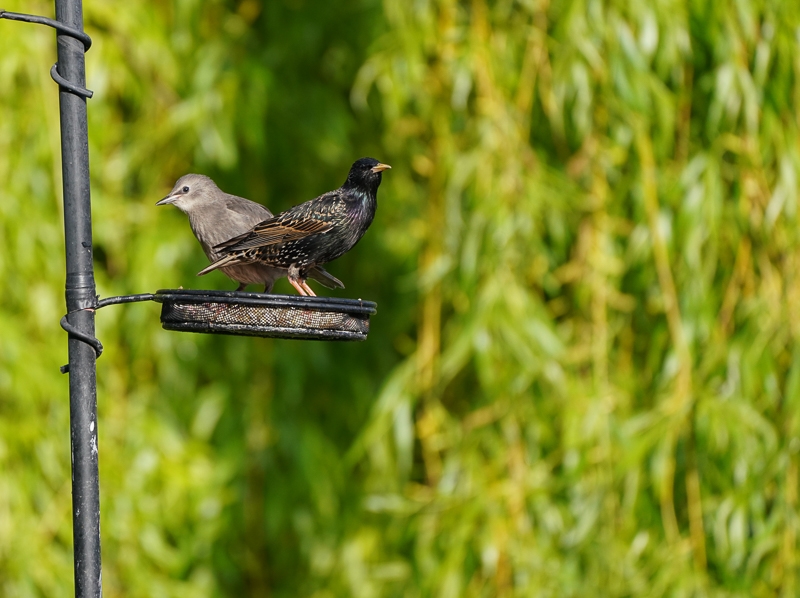
A 2021 study by Shutt and Lees asks whether we’re 'killing with kindness’ by feeding our garden birds. Are we doing more harm than good?
WHAT ARE THE BENEFITS OF FEEDING BIRDS?
Anyone who has ever watched birds on bird feeders knows how much joy it can bring, so I won’t drown us in references to studies on the mental health benefits of this way of connecting with nature. Feeding garden wildlife is the most common active human-wildlife interaction globally, so the wellbeing benefits are not to be sniffed at.
Feeding the birds is also an important way for people to reconnect with the natural world: we feel more relaxed and connected to nature when we watch garden birds.
Let’s not forget about the positive impacts for the birds themselves. Direct effects on the recipients of provisioning (i.e., the birds in our garden) are well-documented in the study and include:
increased survival;
increased productivity;
increased individual health and quality of life;
increased breeding densities;
increased ranges/residencies; and
population growth.
Supplementary feeding is making a positive difference to farmland birds, for instance, which are in decline.
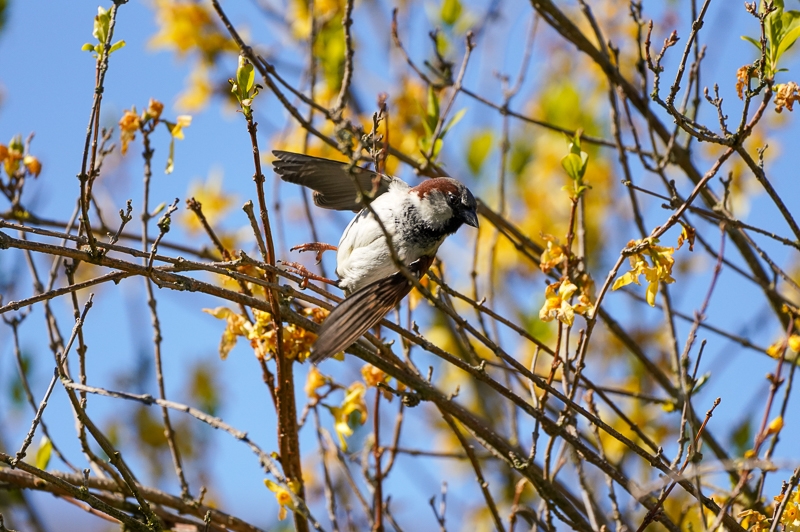
WHAT ARE THE RISKS OF FEEDING BIRDS?
There are some well-known risks to recipient species too, such as predation by domestic cats, transmission of disease, and window collision – as well as some more uncertain risks, such as dependency, poor nutrition, or biological changes where food of poor nutrition is provided.
Shutt and Lees argue that provisioning could also be contributing to widespread ecological community change and homogenisation.
Some conservation organisations have been criticised (sometimes rightly, sometimes wrongly) for over-focusing on individual species of special conservation concern to the potential detriment of other species or the wider ecosystem. This argument is sort of the opposite: that general provisioning favours a range of common and adaptable species to the detriment of a smaller number of less adaptable species.
WHAT IS HOMOGENISATION?
Homogenisation is the process by which things become uniform or similar. In the conservation context, it’s a serious concern. The health of much of the natural world relies on biodiversity – millions of species of plants and animals interacting in millions of different ways.
When homogenisation hits, biodiversity is severely limited and places that used to host different groups of species begin to host the same, more limited, group of species. We’re already seeing the start of homogenisation where the spread of invasive species, particularly to islands, is having catastrophic effects on resident biodiversity.
In his book on invasive species, Daniel Simberloff wonders whether we will enter ‘the Homogenocene’, an era where biodiversity declines across the world to the extent that we’re left with the flora and fauna in each country looking suspiciously similar, instead of brilliantly diverse.
HOW DOES HOMOGENISATION HAPPEN?
Homogenisation happens when a dominant and adaptable species drives out less dominant, less common, and less adaptable species such that instead of having, say, ten species of evenly matched birds (or at least unevenly matched birds that can successfully compete) that visit a particular piece of habitat, you end up with lots of the same bird.
A real-life example is rosy wolf snails introduced on the Hawaiian Islands, which caused the extinction of at least 50 other species of snails. In place of 50 there is now one: things have become more uniform.
When this happens at a landscape, country, or global scale the effects on biodiversity are catastrophic.
HOW COULD FEEDING CONTRIBUTE TO HOMOGENISATION?
Any answer to this question that doesn’t fill a chapter will lack nuance, but a generalised answer is that feeding favours species that can access that food most readily.
A tray of seeds in an urban garden will benefit species that are adapted to urban environments – for instance, ones used to being out in the open, who aren’t dependant on woodland-specific nesting cavities, and who are dominant on the feeding tray.
Everyone who feeds the birds knows about the chain of command. If you put food on a tray, the majority will be eaten by wood pigeons. If you want to feed goldfinches, you need a tall feeder. If you want to feed tits and dunnocks, a feeder in the bushes. Starlings like suet, robins love mealworms. There are some species, though, that lie outside all of this as they very rarely visit feeders: willow tits are the poster species.
There are also some less obvious contributors to homogenisation. For instance, an increase in generalist species due to feeding will boost predator populations, but the predators will also feed on species who don't benefit from the additional feeding. The increase in predators is balanced for the fed species – because their population also increases – but not for the species that don’t benefit from the feeding.
Mesopredator (mid-ranking predator) numbers can be directly increased by feeding (magpies, crows, rats etc. on our feeders), which has been shown to affect the population size of young mammals and birds.
Another way that feeding can contribute to homogenisation is in removing the benefits of evolutionary niches.
In the natural world, species that compete for resources in the same habitat evolve in ways that allow them to hold their own within that competition; for instance, they may be better at extracting a given food source than competitors, or better at nesting in difficult locations. Sometimes feeding or providing nest boxes can wipe out these advantages by effectively providing the benefit of that evolutionary niche to the fed species, undercutting all the hard work of evolution in allowing competing species to co-exist.
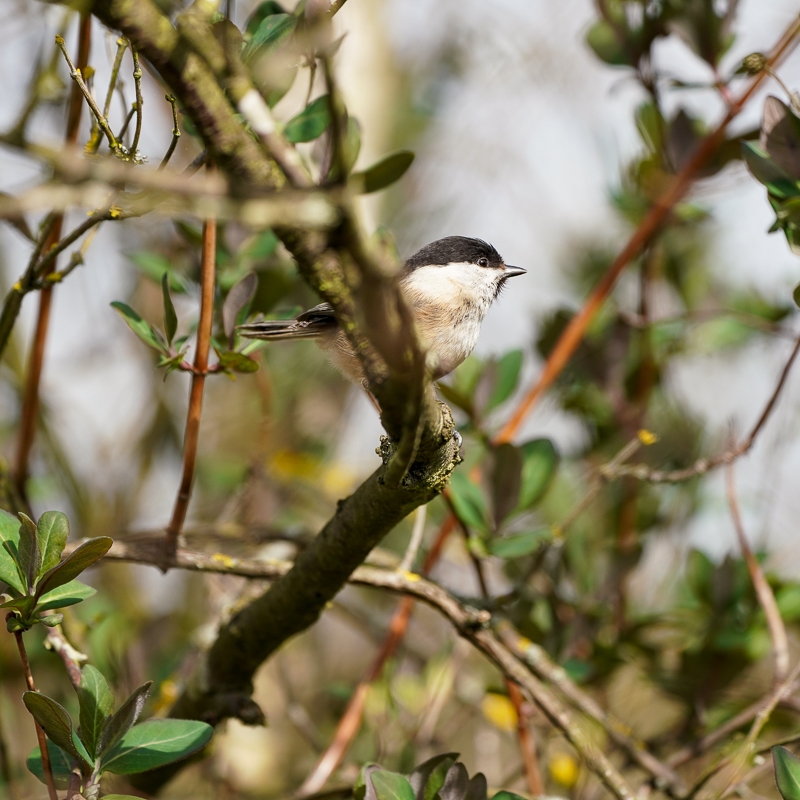
A willow tit
THE CASE OF WILLOW TITS
Willow tits aren’t dominant in their habitat: the dominant species are blue tits. The willow tits survive through their ecological niche: these enterprising little birds excavate their own nest cavity. This means that when it comes to available nesting space, willow tits have the upper hand because they can create their own.
Blue tits have long kicked willow tits out of their carefully excavated cavities and taken them for themselves, but this wasn’t a threat to the willow tit’s population numbers when the ratio of blue tits to willow tits was balanced by the availability of food in the habitat.
Now, though, blue tits visit feeders and willow tits don’t. Blue tits don’t stick to our gardens, so all the extra baby blue tits raised on the parents’ energy from eating at our feeders disperse into woodland and kick more willow tits out of their nests.
Couple this with the fact that blue tits use nest boxes and willow tits don’t – and the fact that we’ve been installing nest boxes in woodland – and you’ll see why the authors of the study argue that feeding benefits blue tits at the expense of willow tits.
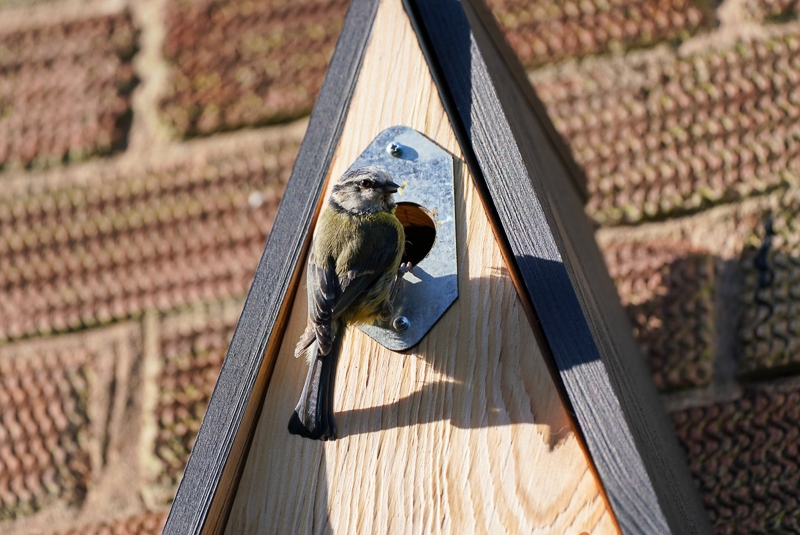
WINNERS AND LOSERS
A graphic in the article shows increases in populations of birds that use feeders – like great tits, blue tits, great spotted woodpeckers, nuthatches, and invasive ring-necked parakeets – and declines in species that don’t use feeders – like marsh tits, willow tits, lesser spotted woodpeckers, pied flycatchers, and wood warblers.
At the moment this is correlation not causation: there is no direct evidence that feeding has led to these declines, but the reasons why it could have done are the ones explained above.
The first thing to note about the graphic is that it's selective. It gives the impression that all feeder-visiting birds are increasing at the expense of birds that don't visit feeders, but let's not forget that there are plenty of bird species that visit feeders whose numbers are also in decline, and whose falling population numbers are supported (to some extent at least) by feeding.
House sparrows are often on our feeders, but there are 247 million fewer sparrows in Europe now than in 1980. Starlings - those joyful, chattering, rainbow birds that bicker over suet balls - have declined by 75 million. Other feeder-visiting species that have suffered decline include chaffinches, coal tits, tree sparrows, bramblings, and bullfinches.
Another element that the graphic fails to capture is what would have happened to the population numbers of the feeder-visiting birds if feeding didn’t happen, given we know that feeding can increase health and population.
Seeing increases in feeder-visiting populations at the apparent cost of decreases in other species’ populations is distressing – and the upset in the balance of competition is obvious (even if not directly proven) – but given the terrible state of natural habitat in the UK (we’ve led the world in destroying the natural environment) would the picture without feeding have been just as bleak? Would we have seen declines in population numbers across the board, instead of increases in some and decreases in others?
It’s hard to say, and it’s debatable whether decline across the board is worse than uneven increase and (potentially) associated decline (due to the risk of homogenisation), but the complexity in even such a seemingly straightforward comparison serves to illustrate the challenges of deciding whether to feed the birds.
If the increase in feeder-visiting species has directly led to a decline in species that don't visit feeders, what extra pressure is this exerting and how much of the decline is due to other factors, like habitat decline? We don't know the answers to these questions yet.
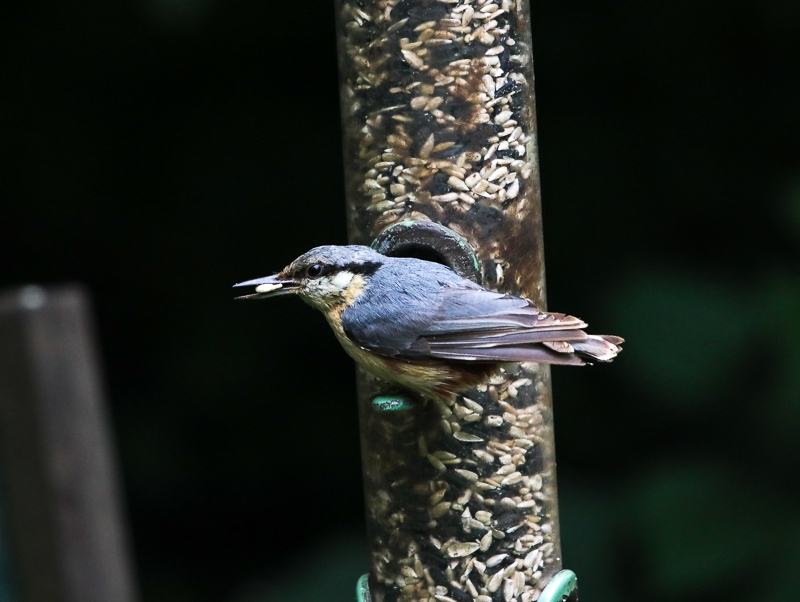
THE COST OF PRODUCTION
Buying bird food has a carbon footprint. It’s heavy, and it has been shipped to us, often from afar. We also require land to grow bird food on, and that use of land could result in deforestation or include poor land management practices that harm biodiversity.
The authors point out that on a global scale this is particularly relevant where the food – such as niger seed – is grown somewhere with very high levels of biodiversity. Using land to grow bird food in these regions may reduce biodiversity there to a far greater extent than it increases it wherever the bird food is offered.
THE ROLE OF CONSERVATION CHARITIES
Feeding birds is encouraged by all of our well-loved conservation charities: the Wildlife Trusts, the Woodland Trust, the British Trust for Ornithology, and the RSPB among others. Why?
The authors of the 2021 study mention that these organisations receive financial income from selling or promoting bird food, perhaps suggesting a conflict of interest or shady reasons for encouraging the practice.
I’m a huge fan of pointing out conflicts of interests and acknowledging the possible role of financial incentives, but in this context, I think any insinuation to that effect would be unfair.
All the organisations’ trading incomes (only a fraction of which are attributable to provisioning wildlife) are dwarfed by their income from other sources, as a glance at their annual reports will show, and as large organisations full of clever and committed individuals, even someone as cynical as I am when it comes to corporate behaviour wouldn’t believe they’d put profit before principle when the profit (if any) is insignificant for the organisation.
I think it’s much more likely that these organisations encourage feeding because of the strong, demonstrated benefits of doing so. There are extensive arguments on both sides of this camp, with either view (to feed or not to feed) being completely justified.
It seems that, to date, our conservation organisations have considered the matter and come down on the side of encouragement – perhaps because of their focus on the importance of engaging the public with the natural world, or because of the strong positive results for feeder-visiting species.
WHAT’S THE SOLUTION?
I usually hate this sentiment as it's often used as a cop-out, but far more research is required in this area before it’s easy to say what the best solution is. It’s understandable why some argue for us to stop feeding the birds and providing nest boxes.
The argument of not changing potentially harmful behaviour until research conclusively proves the harm is weak when the only possible outcomes of changing the behaviour are good or neutral, but when the consequences of doing so probably include declines in the populations of feeder-visiting birds (worsening the decline of species like house sparrows and starlings), is the argument more valid?
I think this complex question is representative of a much wider tension in conservation. Interfering in any way – no matter how well-intentioned – will have some negative effect on some aspect of the natural world.
The desire to leave the natural world to do her own thing is very strong in all of us who care about her, but the fact of the matter is that we’ve wreaked so much havoc on the natural environment that nothing quite works as it should anymore without a bit of help.
How we direct that help is the topic of many a heated argument, supported by many conflicting scientific studies. It's extremely difficult to balance our help and the effects of our help equally between species.
We've known for a while that very targeted measures for one species can inadvertently negatively affect other species, and this study shows that even wider measures that benefit many species may have a negative effect on some species.
Even wide-scale habitat restoration can benefit some species at the expense of others - and this last point is the entry point into the debate about what habitat we should strive for, and what time in history we should be seeking to recreate, which is a whole other rabbit hole to go down.
Delving deep into the complexities of these debates is necessary but frustrating, and the light at the end of the tunnel is that, over time, general principles and approaches emerge that are widely supported by both logic, experience, and science.
As individuals, I think the best we can do is to follow these general principles and approaches, adjusting our behaviour in line with emerging consensus whilst always considering issues on a personal level.
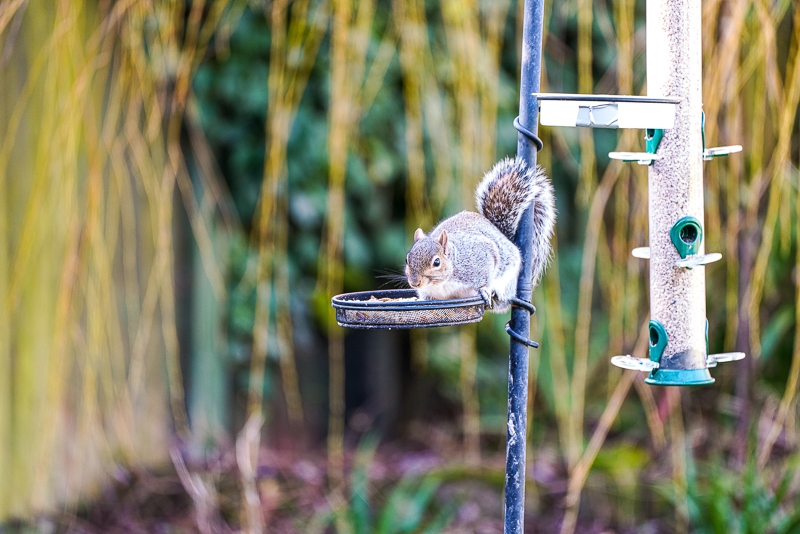
A STEP DOWN OR A STEP UP?
One of the problems with wanting to cease supplementary bird feeding is the lack of natural habitat in the UK.
The flip side of the argument that our feeding is having a big impact on populations of non-dominant birds by boosting the numbers of dominant birds must necessarily be that if we all stopped feeding the birds tomorrow, there would be large declines in population numbers of birds commonly found on feeders, and there’s a question whether that’s something we’re able to bear, given the nature-depleted state of our country (even if it’s true that it’s for the best overall).
I wonder if, instead, the answer is stepping up efforts for species that don’t visit feeders. Barring any big increase in feeding, and assuming we know enough about how to support the non-dominant species, logic dictates that if we made an equal effort for birds that don’t visit feeders, we could increase the population of all bird species – allowing natural population ratios to re-stabilise.
If the problem is that we’ve upset the competitive balance by giving one group of species a leg up, instead of dropping them back down on the floor, could we find ways to give the other species a leg up too?
Our conservation organisations have already started on this front; the RSPB is running a willow tit recovery project, and research continues into the best ways to level the playing field for our wild birds.
WILL YOU KEEP FEEDING THE BIRDS?
I still feed the birds. In the face of evidence that it directly benefits species that visit feeders (including some species that are in decline - albeit ones with a larger overall population number than the likes of willow tits) and without a clear understanding of what would happen if we all stopped offering food (both in terms of the negative effect on feeder visiting birds and the scale of the positive impact on birds that don't visit feeders), I’m not quite ready to give it up.
I’m considering it and will keep an eye on emerging research. I recognise the compelling arguments in favour of reducing supplementary feeding whilst increasing natural habitat.
Whether you decide to stop feeding the birds or providing nest boxes will depend on your views on the relative strengths of the scientific, theoretical, and moral arguments on each side. It’s not an easy choice to make between supporting a thriving goldfinch population (who have been massively helped by feeding) and potentially allowing a willow tit population to thrive.
Nobody wants to feel like they've been inadvertently causing harm but there's no use burying our heads in the sand: we feed the birds and provide nest boxes because we want to help them, so if there's evidence it might be causing harm then we need to consider it.
Share with your friends
Subscribe to learn more
Join me in exploring our natural world and cultural heritage as we learn how to protect and restore it. Get notified on my latest posts and a monthly newsletter on wider conversation topics for us to chat about.
Recent Posts
If you enjoyed this one, then you might like these too.